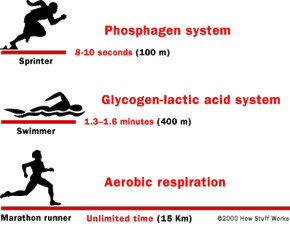Exercise and the Glycogen-Lactic Acid System
Muscles also have big reserves of a complex carbohydrate called glycogen. Glycogen is a chain of glucose molecules. A cell splits glycogen into glucose. Then the cell uses anaerobic metabolism (anaerobic means "without oxygen") to make ATP and a byproduct called lactic acid from the glucose.
About 12 chemical reactions take place to make ATP under this process, so it supplies ATP at a slower rate than the phosphagen system. The system can still act rapidly and produce enough ATP to last about 90 seconds. This system does not need oxygen, which is handy because it takes the heart and lungs some time to get their act together. It is also handy because the rapidly contracting muscle squeezes off its own blood vessels, depriving itself of oxygen-rich blood.
Advertisement
There is a definite limit to anaerobic respiration because of the lactic acid. The acid is what makes your muscles hurt. Lactic acid builds up in the muscle tissue and causes the fatigue and soreness you feel in your exercising muscles.
